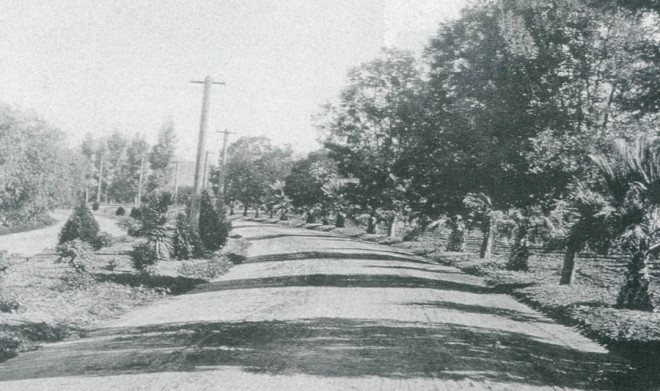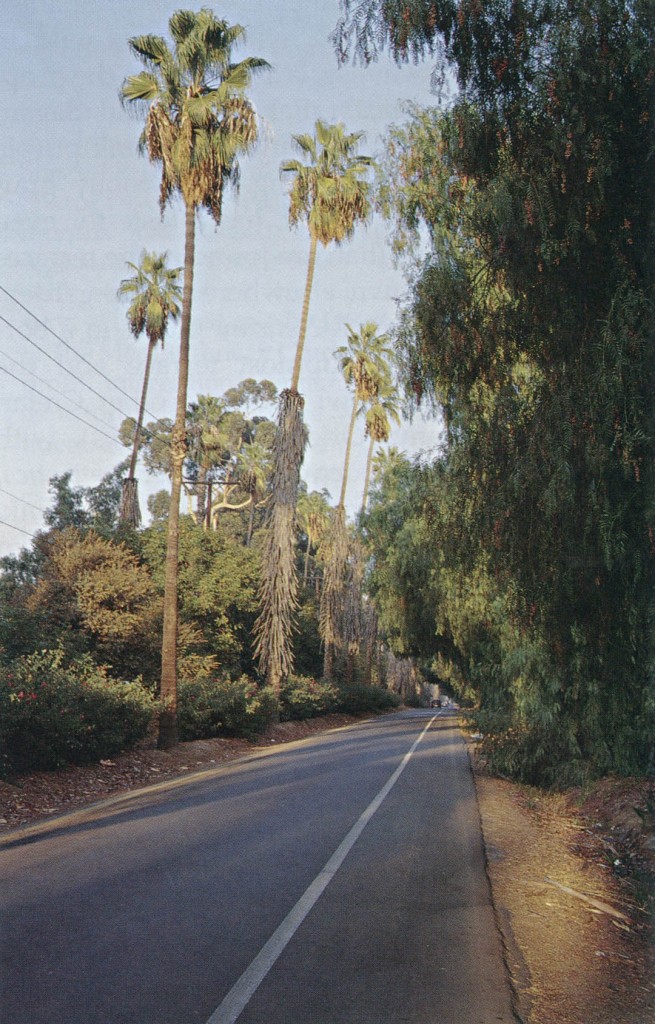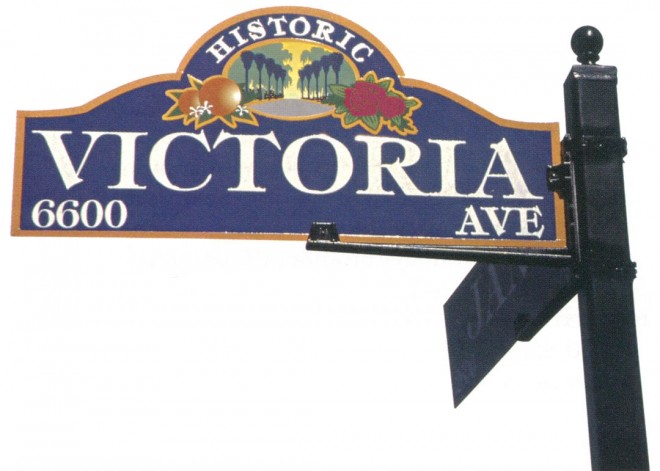
Victoria Avenue

Contributor
Victoria Avenue in Riverside, California has been one of the city’s best-loved features for over one hundred years. In spite of encroaching urbanization, the orange groves through which it passes are a vivid reminder of Riverside’s rich citricultural heritage.
Recently listed on the National Register of Historic Places as an outstanding example of a “cultural landscape,” Victoria Avenue is a broad, landscaped thoroughfare, 120 feet wide with two traffic lanes, one in each direction, separated by a thirty-foot median. The median and side parkways are planted with trees, shrubs and roses. In effect, the avenue is a linear park and arboretum, seven and a half miles long, that is perfect for walking, jogging, and bicycling, or for a leisurely Sunday drive.
So it came as a great shock in 1990 when large, red dots began appearing on some of one-hundred-year-old eucalyptus trees along Victoria Avenue. A subsequent article in the local press explained that these trees were slated for removal. Fearful that they would not be replanted, a group of concerned activists met to consider options. Thus was born Victoria Avenue Forever (VAF), a tax-exempt non-profit organization dedicated to the “preservation, protection, and beautification” of the avenue. Membership quickly grew and today stands at over 500.
A comprehensive management plan was the first priority. At the instigation of VAF, a committee was formed to address major concerns, such as the care of existing plantings, ongoing replanting, weed and pest control, irrigation, and even signage. As one result of the plan, for example, furrow irrigation of the median plantings was abandoned in favor of water-efficient drip irrigation.
Searching for a highly visible project for the fledgling organization, volunteers were sought to plant six missing median trees in June 1991. The turnout was so astounding that another such event was scheduled for that fall. This time, people were invited to donate a tree in memory of a loved one or to commemorate a special occasion. The response was, and continues to be, overwhelming. In ten years, VAF volunteers have planted some 800 trees, almost all of them commemorative trees. Not only has the community seen results, but donors and volunteers alike have acquired a sense of “ownership” of Victoria Avenue and a vested interest in its preservation.

A Vision
Victoria Avenue exists because of an exciting discovery and one man’s vision. In the mid-1870s, the US Department of Agriculture sent to Riverside a number of young orange trees to test for their commercial potential. When they bore, one had seedless fruit of superb flavor. Winter-ripening, the Washington navel orange, as it was named, was a hit on the East Coast. Ideally suited to the soils and climate of the Riverside area, it was soon being propagated at the wholesale level from the parent Washington navel tree, which still grows in its own little park on nearby Magnolia Avenue. The land boom was on, and thousands of acres were planted with the new orange.
Shortly after, in 1881, Matthew Gage, a young Irish‑born jeweler, arrived in Riverside and started buying water rights in the Bunker Hill Basin of the Santa Ana River near San Bernardino. In the late 1880s, with no known engineering background, Gage began construction of a twelve-mile canal to bring water to a section of land he had claimed under the Desert Land Act. As the canal neared completion, Gage purchased another 5000 acres of prime orange‑growing land. The Gage Canal was extended eight miles to irrigate this tract, now named Arlington Heights. Gage’s plan was to sell grove properties to recoup his costs.
However, Gage was by now over-extended, and he was forced to sell his land and canal to the London-based Riverside Trust Company, Ltd. In July of 1880, the Trust Company filed the Arlington Heights subdivision map with the broad Victoria Avenue conceived as a means of access, but also as a sales promotion tool.

Planting Begins
Planting on Victoria Avenue began in the spring of 1892, under the direction of Franz Hosp, Riverside’s pioneer landscape designer. Hosp’s plan is a masterpiece of drive-by landscape planting, as appropriate to the horse-and-buggy era as it is to the automobile age.
Over the years some of the plant material has changed, but the original concept has not altered. In general, the median of each quarter-mile-long block is planted to one, and occasionally two, species of small, deciduous, flowering trees or large shrubs. Included are saucer magnolia (Magnolia x soulangiana), redbuds (Cercis occidentalis and C. canadensis ‘Oklahoma’), crape myrtle (Lagerstroemia indica), chaste tree (Vitex agnus-castus), pyracantha (Pyracantha crenatoserrata, syn. P. fortuneana), red horsechestnut (Aesculus x carnea ‘Briotii’), Callery pear (Pyrus calleryana), flowering peach (Prunus persica), flowering nectarine (Prunus persica var. nucipersica ‘Alma Stutz’), Caesalpinia spinosa, Chinese fringe tree (Chionanthus retusus), Spiraea nipponica, flowering crabapple (Malus ‘Hopa’), pink trumpet tree (Tabebuia impetiginosa, syn. T. avellanedae) and dombeya (Dombeya cacuminum).

Standing at attention on both sides of the median, like so many soldiers, are some 1100 Mexican fan palms (Washingtonia robusta). Grown from seed by a local orange grower and planted by his field hands in the early 1900s, they have attained a uniform height of more than one hundred feet.
Between the palms are rows of ‘Ragged Robin’ roses (see An Encounter with ‘Ragged Robin’ in Pacific Horticulture, Fall ’93). Thousands of cuttings were propagated and planted in the 1920s by a group of orange growers’ wives and the Trust Company. Recently, Victoria Avenue Forever volunteers have been re-planting missing roses. Once a month, from fall through spring, cuttings are taken and planted directly where they are to grow. The new improved drip irrigation has significantly increased the success rate for this simple propagation program.
As land in Arlington Heights was sold to prospective orange growers, the Trust Company included in each deed a requirement that the holder of title was “to plant and maintain . . . on such lines as may be described by the Engineer of said Riverside Trust Company, Limited, shade or ornamental trees” along his street frontage. After the turn of the century, the Trust Company concentrated less on land sales and more on growing oranges in its own interest, but it still continued to plant trees along all the streets in Arlington Heights.

Parkway Trees
The Victoria Avenue parkway trees are quite different from the median trees. They are much taller, large-crowned, evergreen and, except for the jacarandas (Jacaranda mimosifolia) and southern magnolias (Magnolia grandiflora), not as showy in bloom. Again, each block is planted to only one species, or to two alternating species, reflecting a very conscious design decision. Interestingly, none of the parkway trees is a conifer, save for one block that has Italian cypress (Cupressus sempervirens) alternating with California fan palms (Washingtonia filifera).
Perhaps the most impressive parkway trees are the more than 300 eucalypts. Among the fourteen species of Eucalyptus planted there can be found the ubiquitous E. globulus along with E. camaldulensis, E. nicholii, and E. viminalis. Some are more than ten feet in diameter at breast height and well over one hundred feet tall, with huge, off-white trunks, often picturesquely contorted, attesting to their great age. Unfortunately, some of the eucalypts are now suffering from attacks by eucalyptus borers and lerp psyllids. Other notable parkway trees include silk oak (Grevillea robusta), glossy privet (Ligustrum lucidum), California pepper (Schinus molle), Guadalupe palm (Brahea edulis), and Canary Island date palm (Phoenix canariensis).
Reforestation of the parkway trees is a matter of great concern owing to the uniform age, but there is no dependable source of water for any young trees that may be planted in the future. Formerly, the parkway trees received run‑off water from the groves, but since many growers have converted to drip or spray irrigation, that source is no longer available. Providing another source is prohibitively expensive, though grant funding is being investigated.

Acknowledging a Landmark
The Trust Company deeded Victoria Avenue to the city of Riverside in 1902 with the stipulation that the trees be maintained and protected. The plantings became the responsibility of the Park and Recreation Department, which, in recent years, has turned maintenance over to private contractors.
On June 11, 1969, Victoria Avenue was declared the city’s Cultural Heritage Landmark #8.
In 1993, Victoria Avenue Forever undertook to improve a semi-abandoned plot of land on the northwest corner of Victoria and Jane. The hardscape, irrigation system, and plants were funded by donations, and VAF volunteers did the planting and, to this day, maintain the garden. All the plants are drought tolerant and include such things as Lantana ‘Radiation’, lion’s tail (Leonotis leonurus), Mexican sage (Salvia leucantha), Mexican marigold (Tagetes lemmonii), autumn sage (Salvia greggii), sulfur flower (Eriogonum umbellatum), Mexican palo verde (Parkinsonia aculeata), chitalpa (x Chitalpa tashkentensis) and several species of agaves, aloes and euphorbias. With something in bloom at every season, this garden elicits much favorable comment from those using the avenue.
Soon after planting began on the avenue, Franz Hosp noticed an interesting sport on one of the roses in the median. He propagated it and introduced it to the trade as ‘Cl. Cecile Brunner’; it soon became widely popular throughout California (see page 46). VAF recently planted several examples of this rose on an iron arbor, commissioned for the site. They make an arresting sight at the beginning of the avenue, though most passersby are not aware of their historical significance.
Just across the way from the ‘Cecile Brunner’ roses is a Mexican fan palm planted by President Theodore Roosevelt when he visited the city in 1903. Apparently the city fathers were proud of Victoria Avenue even though it was a mere ten years old. The Roosevelt palm is now the city’s Cultural Heritage Landmark #64.
To make residents and visitors more aware of the botanical richness and historical significance of Victoria Avenue, VAF published a full-color brochure giving names and location of significant features to be seen on the avenue. So far, 25,000 copies have been distributed to nurseries, hotels, libraries, and other locations.
In its ten years, Victoria Avenue Forever has established a good relationship with elected officials and city departments and is recognized as the unofficial watchdog and advocate for the avenue. Its volunteer activities and fund-raising prowess have raised awareness of and appreciation for this unique city amenity, and that bodes well for the second century of Victoria Avenue.
Share:
Social Media
Garden Futurist Podcast
Most Popular
Videos
Topics
Related Posts

Ground Up Science for Greener Cities with Garden Futurist Dr. Alessandro Ossola
Spring 2023 Listen to the Podcast here. Alessandro Ossola is a scientist who gets very excited about the challenge of climate change allowing for an

Readying Urban Forests for Climate Realities with Garden Futurist Dr. Greg McPherson
Winter 2023 Listen to the Podcast here. “Going from the mow and blow to a more horticulturally knowledgeable approach to maintaining the landscape. And that

Low Maintenance Gardens – Better for Pollinators and People
Autumn 2022 “I come out every day. It’s therapy, my meditation.” Janet’s young garden transformed from overgrown, invasive plants to mostly natives. The dailiness of

Invasive Plants Are Still Being Sold: Preventing Noxious Weeds in Your Landscape
Autumn 2022 With so many beautiful ornamental plant species and cultivars throughout California and the Pacific Northwest, how do you decide which ones to include











Responses